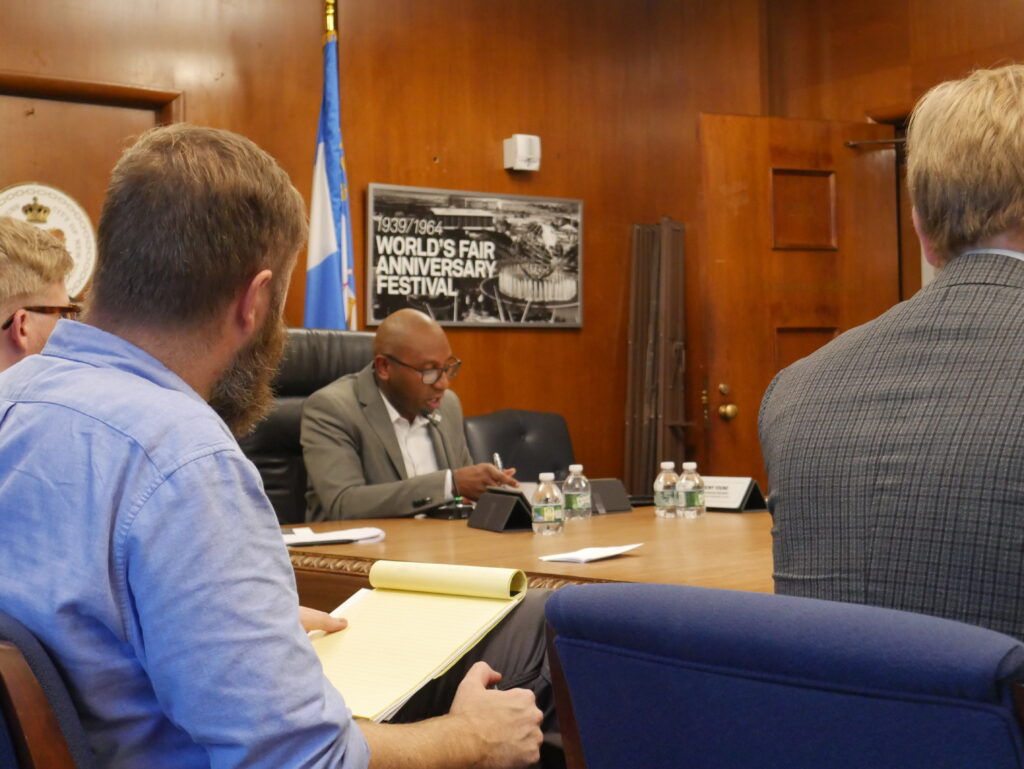By Oona Milliken | omilliken@queensledger.com
The Interborough Express plan keeps chugging along, as the Metropolitan Transit Authority moves forward in their plans of converting 14 miles of freight tracks into a functional commute way for Brooklyn and Queens residents. On Monday, Sept. 18, the Queens Borough Board met with Borough President Donovan Richards and MTA representatives in Borough Hall to discuss the specifics.
Sean Fitzgerald, Deputy Chief of Staff for the MTA, led with a presentation to update the community on the MTA’s findings on how much the railway would cost, plans for construction and preliminary findings of their study. According to Fitzpatrick’s presentation, the rail would be incredibly useful for people traveling in Queens and Brooklyn, a notorious subway desert.
“There’s increasing demand for travel within Queens, and between Brooklyn and Queens directly. We think that within this study area, there are more people who commute within Brooklyn and Queens than go into Manhattan,” Fitzpatrick said. “We anticipate, with forecast modeling, something like 115,000 weekday riders, which would be a substantial addition to the MTA portfolio.”
The express is set to run from Bay Ridge in Brooklyn to Jackson Heights in Queens. According to Fitzpatrick, the subway line would connect to 17 other subway lines, as well as the Long Island Railroad, and save commuters almost half an hour spent traveling. The MTA has decided to move forward with light rail, which would be both cheaper and faster than traditional subway tracks, though the project is still expected to cost roughly $5.5 billion. A light rail would entail smaller, lighter vehicles and an above-ground rail through Brooklyn and Queens.
Some board members balked at the multi-billion dollar price tag. Frank Taylor, chairperson for Queens Community Board District 3, said he would like to see the MTA conduct proper maintenance before spending more money on a new project, and addressed his concerns to Fitzpatrick. In 2019, a piece of wood struck and damaged a car underneath the 7 train on Roosevelt Avenue in Queens during renovation efforts.
“You’re doing a 7 train renovation now, the 7 line, and the train actually fell and hit people’s cars and other things. It had been all over the news before you guys did anything. Maintenance is not something you guys do,” Taylor said during the meeting. “What I see in areas of which I reside, black and brown areas, you’re putting band-aids on these structures that are here instead of redoing [them].”
Other community board members worried about the possibility of relocating individuals near the railway, and how it would impact community members living near the train track. Heather Beers-Dimitriadis, chairperson for Community Board 6, asked what the MTA was doing in order to prevent people’s homes from being demolished during the construction.
“You talk about not wanting to disrupt cemeteries, which I get, but I’m also wondering about the people who are living,” Beers-Dimitriadis said to Fitzpatrick. “Are you looking at the possibility of having to eliminate a house here, a house there, in order to make this line work, or building here, a building there, in order to accommodate this?”
Other community members at the meeting voiced similar concerns, including Davita Brown, who said she wanted to come to the meeting because she was worried it would disrupt her own neighborhood. After the meeting, Brown said she agreed that Queens needed more transportation, but thought that all new construction would come at the expense of community members’ quality of life. She also said she was concerned with the maintenance of existing railway lines, much like Taylor.
“The quality of life will change no matter what you do. We have to make up our mind on community members’ quality of life to have more transportation. You cannot advance without some sort of change,” Brown said. “We already have problems with maintaining the stuff they already have. There’s no intervention, there’s no prevention, they just wait for it to blow up.”
Fitzgerald fielded all questions from community members and said that the plan was just in the preliminary stages of development. In response to Taylor’s concerns, Fitzgerald said he appreciated the feedback from community members and stressed that there was new leadership within the agency that wanted to prioritize underserved populations and to keep community voices at the forefront when developing new railways.
“The MTA is looking to change that,” Fitzgerald said. “We have a lot more work to do, and sort of get us to a place that you’d like us to be, and that we would like to be, but I think that this MTA has made a lot of steps to move us in that direction and hold our feet to the fire as we keep trying to get stuff done.”



